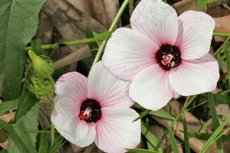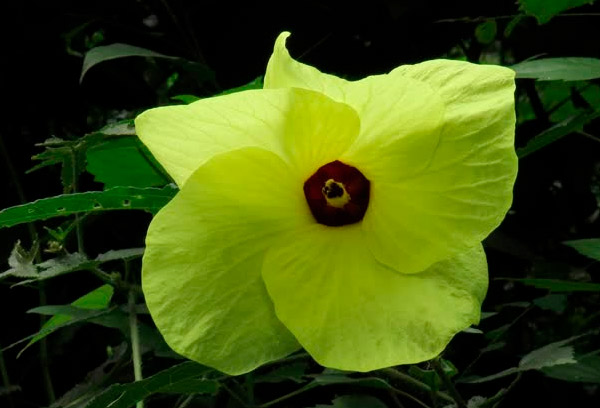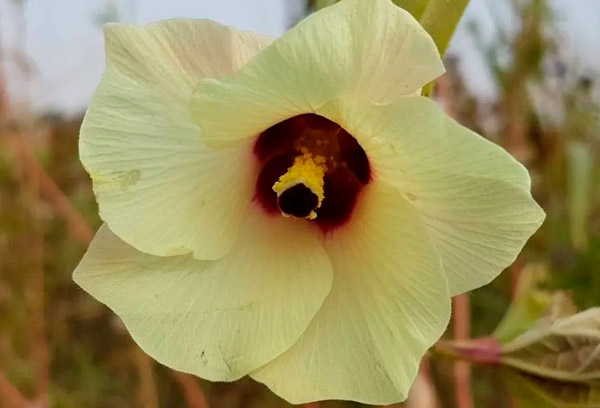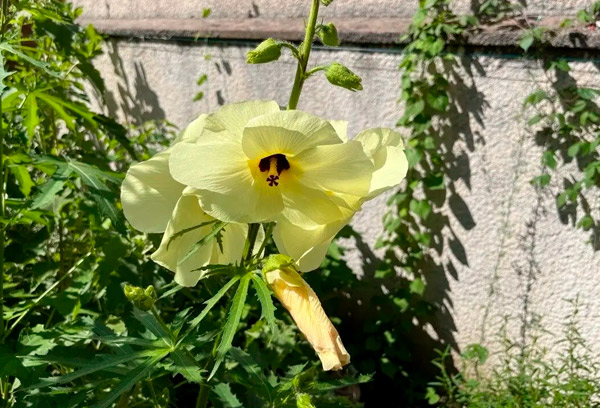New publications
Plants
Abelmoschus
Last reviewed: 11.03.2025

Abelmoschus (Latin: Abelmoschus) is a genus of herbaceous plants that includes popular species used in cooking (such as okra) and in ornamental horticulture (such as Abelmoschus moschatus, or musk mallow). Plants in this genus attract attention due to their large, beautiful flowers resembling hibiscus flowers, as well as edible fruits in some species. In the wild, abelmoschus is found in tropical and subtropical regions of Asia and Africa, where it grows in open, sunny locations with sufficient moisture.
Etymology of the name
The name "Abelmoschus" comes from the Arabic word "abu-l-misk," meaning "male musky plant" or "musky father." This name is related to the fact that some species of abelmoschus, such as Abelmoschus moschatus (musk mallow), have seeds and plant parts that emit a characteristic musky aroma, highly valued in perfumery and folk medicine.
Life form
Abelmoschus typically forms an erect herbaceous stem that may become woody at the base as the plant matures. Depending on the species, the height ranges from 50 cm to 2 meters or more, although more compact forms are usually cultivated. The leaves are often lobed or palmate, arranged alternately.
In ornamental horticulture, some species of abelmoschus are grown as annuals because they can develop and bloom quickly during one season. However, in favorable conditions (tropical or subtropical climates), these plants can live for several years, forming larger stems and more robust root systems.
Family
Abelmoschus belongs to the Malvaceae family. This family includes several well-known genera and species that are used by humans for food, as ornamental plants, and for medicinal purposes (e.g., hibiscus, cotton, mallow).
Malvaceae plants are characterized by large flowers with five petals, often with a prominent central column and fused stamens. Many members of this family contain mucilaginous substances in their stems and leaves, which give them certain practical uses (e.g., okra, flax-leafed species, and other crops).
Botanical characteristics
The leaves of abelmoschus can vary in shape, from oval to deeply lobed, depending on the species. The flowers are usually solitary, large, funnel-shaped, with five petals, and are found in the axils of the leaves. The color of the petals ranges from white and yellow to pink and red; some species have a contrasting dark center.
The fruit of abelmoschus is typically an elongated, slightly five-sided capsule inside which seeds form. In some species (e.g., Abelmoschus moschatus), the seeds contain aromatic compounds (musk scent). The root system is taproot, well-developed, which helps the plant withstand short periods of drought.

Chemical composition
Various parts of abelmoschus (leaves, stems, seeds, flowers) contain flavonoids, anthocyanins, tannins, and other biologically active compounds. The seeds of some species are rich in essential oils that have a musky aroma, due to the presence of specific lactonemacrolides.
The leaves and young shoots of okra (Abelmoschus esculentus) contain mucilaginous substances (polysaccharides), which give dishes a viscous consistency. Because of this, okra fruits are used in the cuisine of many tropical countries. The chemical composition of the shoots and seeds also allows the plant to be used in folk medicine.
Origin
Abelmoschus is native to the tropical and subtropical regions of the Old World (Africa, Asia). From here, some species spread along trade routes and were cultivated for their edible and ornamental qualities. The most well-known form is okra (Abelmoschus esculentus), which has become an important vegetable crop in many countries.
Today, its distribution includes Asia, Africa, South America, and some regions with suitable climates in North America and Europe. In places with cold winters, abelmoschus is grown as an annual or in greenhouses.
Ease of cultivation
Abelmoschus is relatively easy to grow if it is provided with enough heat and light. Many species can be grown from seeds, which germinate at temperatures above 20°C, and seedlings quickly develop green mass and begin to bloom.
The main challenges arise from insufficient light, overwatering, or, conversely, prolonged drought periods. By providing the plant with regular, moderate watering, good drainage, and enough space, steady growth and blooming can be achieved without much difficulty.
Species and varieties
The genus Abelmoschus includes about 15–20 species, the most well-known of which are:
- Abelmoschus esculentus (okra) — an important vegetable crop with edible pods;

- Abelmoschus moschatus (musk mallow) — known for its seeds with a musky aroma, used in perfumery and folk medicine;
- Abelmoschus manihot — an ornamental plant with large yellow flowers.

There are many cultivars, especially of okra, where breeders have developed varieties with different pod lengths, colors, and maturation times.
Size
The height of most species of abelmoschus ranges from 0.5 to 2 meters depending on soil fertility and growing conditions. In greenhouse or tropical conditions, individual specimens can reach up to 3 meters, forming dense foliage and numerous side shoots.
The diameter of the bush also varies, especially in perennial species that can spread out. For container cultivation, dwarf or less tall varieties are usually chosen, which are easier to control by pruning and pinching.
Growth rate
Abelmoschus grows fairly quickly under favorable conditions, with high temperatures (around 25–30°C) and sufficient watering. In one season, annual forms (okra) can form a powerful bush that produces edible fruit.
In conditions of insufficient light, low temperatures, or excessive watering, the growth rate slows down. The plant may shed leaves, bloom less frequently, and form less green mass. Proper agronomy allows the full potential of rapid growth to be realized.
Lifespan
Most cultivated forms of abelmoschus are grown as annual crops (okra) or short-lived perennials. However, in warm climates or greenhouses, some species can live for several years, continuing to form shoots and bloom.
Okra is usually harvested after fruiting, while ornamental species (e.g., Abelmoschus moschatus) may last longer. With timely pruning and repotting into larger containers, the plant can continue to bloom and bear fruit for several seasons.
Temperature
The optimal temperature for the growth and blooming of abelmoschus is 20–30°C. When the temperature drops below 15°C, growth slows, and flowers and leaves may drop. During short-term cool spells (around 10°C), the plant stops vegetating and enters a stressed state.
In excessively hot climates (above 35°C), if insufficiently watered, the leaves may wilt, and buds may drop. In such scenarios, increased humidity control and shading during midday hours are required.
Humidity
Abelmoschus prefers moderately humid air but is not as demanding on humidity as some tropical crops. Significant drying out of the air or soil leads to wilting leaves and reduced flowering intensity.
Optimal relative humidity is 50–60%. In heated rooms with low humidity, you can mist the leaves or place the pot on a tray with moist expanded clay. It is important not to allow water stagnation in the pot.
Lighting and room placement
Abelmoschus prefers bright sunlight, up to 6–8 hours of direct light per day. In indoor horticulture, it is best placed on southern or southeastern windowsills, where the plant will receive enough heat and light.
In conditions of insufficient lighting (northern windows, shaded areas of the room), growth slows, shoots elongate, and flowering becomes sparse. During the winter, with shorter days, additional lighting with grow lights may be necessary, especially if the plant continues to vegetate.
Soil and substrate
The ideal soil mix for abelmoschus is loose and nutritious, with a neutral or slightly acidic pH (6–6.5). A recommended composition is:
- 40% universal garden soil;
- 20% peat;
- 20% coarse sand or perlite;
- 20% humus or leaf soil.
A drainage layer of expanded clay or gravel (1.5–2 cm) is essential at the bottom of the pot to prevent water stagnation. Excessive compaction of the soil leads to slowed growth and root rot.
Watering (summer and winter)
In summer, abelmoschus requires regular and abundant watering, especially on hot days when evaporation increases. The soil should remain evenly moist but without excessive waterlogging. The top layer (1–2 cm) can slightly dry out between waterings.
In winter (or during the cool season), when growth slows down, watering is reduced, providing only moderate moisture as the soil dries. If the plant is at temperatures below 15°C, overwatering is extremely dangerous for the root system.
Fertilizing and feeding
During the active growing and blooming period (spring–summer), abelmoschus should be fertilized every 2–3 weeks with balanced mineral fertilizers containing equal amounts of nitrogen, phosphorus, and potassium. Organic fertilizers (such as cow manure or biohumus) may be used as an alternative, but in moderate doses.
Fertilizers can be applied via root feeding (watering with a solution on moist substrate) or less frequently via foliar feeding (spraying leaves with a weaker solution). In autumn and winter, feedings are reduced or stopped, depending on the plant's condition and growing conditions.
Blooming
Abelmoschus demonstrates large, funnel-shaped flowers with a five-part corolla, often brightly colored (yellow, red, pink, white), with a contrasting spot in the center. Some species (e.g., Abelmoschus moschatus) have flowers with a light fragrance.
Each flower typically lives for only 1–2 days, but the overall bloom can last several weeks as the plant forms many buds. Regular removal of faded flowers encourages the formation of new ones.
Propagation
Abelmoschus can be propagated by seeds or cuttings. Seeds are sown in spring at temperatures of 20–25°C, after soaking them for 12–24 hours to speed up germination. Germination typically occurs within 7–10 days.
Cuttings are taken from semi-woody shoots about 8–10 cm long, with lower leaves removed and rooted in a moist substrate. It is recommended to use rooting stimulants. Under favorable conditions, roots develop within 2–4 weeks. Rooted cuttings are then planted in separate pots.
Seasonal features
In spring and summer, abelmoschus grows actively, forms buds, and blooms. During this period, it is important to ensure abundant watering, regular feedings, and good lighting. With proper care, the plant can bloom from late spring to early autumn.
In autumn, as temperatures drop and daylight shortens, blooming slows, and some leaves may fall. In winter, the plant enters a resting or very slow-growing phase, watering is reduced, and no fertilizers are applied. In spring, the care regime returns to the "summer" format.
Care features
Abelmoschus requires balanced conditions: sufficient light, moderate watering, and nutritious soil. Lack of moisture leads to wilting, while overwatering causes root rot. Hot conditions require more frequent watering but with control to prevent waterlogging.
The plant responds well to misting its leaves during hot hours of the day (preferably in the morning or evening), but it is important not to overdo it to avoid fungal diseases. Ventilating the room occasionally helps ensure air circulation.
Home care
The first step is selecting the right spot: a southern or southeastern window, or a bright balcony, where abelmoschus will get enough sunlight. If sunlight is too intense, the plant can be shaded with a light curtain during midday.
The second point is correct watering: maintain the substrate in a moderately moist state. Water more often during hot weather, less often in winter. Use soft, room temperature water. Drain any excess water in the saucer to avoid soil acidification.
The third aspect is regular feedings with balanced fertilizers from April to September. It's important not to exceed the dosages to prevent salt buildup in the substrate.
Finally, watch for signs of disease or pests: at the first signs, take appropriate measures (adjust watering, apply treatments, etc.).
Repotting
If the roots fill the pot or the plant looks stressed, repotting should be done in spring. Choose a pot that is 2–3 cm larger in diameter than the previous one to maintain the balance between the root volume and the above-ground part.
Pot material is not critical, but the presence of drainage holes is essential. Place a layer of expanded clay or gravel at the bottom of the pot, then fill with pre-prepared substrate. Water the transplanted plant moderately and place it in partial shade for 1–2 days for adaptation.
Pruning and shaping the crown
Abelmoschus should be pruned to stimulate branching and maintain a compact shape. Trim elongated shoots in early spring or after blooming. Cut with a sharp, sterile tool just above the bud directed outward.
Remove weak, dry, or damaged branches as needed. Regular pinching of young shoots also promotes bushiness and improves the plant's appearance by enhancing bud formation.
Possible problems and their solutions
Common diseases are related to overwatering, causing root rot, or insufficient watering, leading to wilting and leaf drop. The solution is to optimize watering, ensure good drainage, and use fungicides if fungal pathogens are suspected.
Nutrient deficiencies manifest as slow growth, yellowing leaves, and poor blooming. This is corrected by regular feedings with balanced fertilizers. Improper lighting (too much or too little sun) and temperature fluctuations also negatively affect abelmoschus.
Pests
Abelmoschus can be infested with spider mites, aphids, thrips, and whiteflies. These pests appear in conditions of high temperatures, dry air, and poor plant care.
Prevention includes regular inspections, spraying leaves (when not flowering), and maintaining optimal humidity. If pests are found, treat with insecticides or biopesticides as instructed, sometimes repeating the procedure after 7–10 days.
Air purification
Like many green plants, abelmoschus contributes to improving the indoor climate by absorbing carbon dioxide and producing oxygen. The leaf surface can trap dust. However, significant air purification from toxins should not be expected.
The main positive impact is aesthetic: the presence of greenery and flowers positively affects the emotional state, reducing stress and creating a more comfortable atmosphere.
Safety
The sap and seeds of some species of abelmoschus contain substances that can cause irritation if they come into contact with mucous membranes or trigger allergic reactions. In general, the plant is not considered highly toxic, but it is better to wear gloves when working with it (especially when pruning) and wash hands after handling.
Allergic reactions to abelmoschus pollen are rare, but sensitive individuals may experience mild symptoms (runny nose, watery eyes) during peak blooming. In such cases, keep the plant away from bedrooms and children's rooms.
Wintering
In cooler regions, abelmoschus can be moved to a warmer room (20–22°C) in autumn, with reduced watering and feeding. If the species is annual (okra), the plant is usually removed after the season as its ornamental value decreases.
For perennial species, a resting period in winter is important: reducing the temperature to 15–18°C and minimal watering allows the plant to "rest" and accumulate energy for new growth in spring. With the arrival of warmer weather, increase watering and resume feeding.
Useful properties
Okra (Abelmoschus esculentus) is valued for its edible pods, which are rich in vitamins, minerals, and mucilaginous compounds that improve digestion. Musk mallow (A. Moschatus) is used in perfumery (seeds with a musky aroma) and may be part of some folk remedies.
In folk medicine, some species of abelmoschus (especially okra) are used to relieve cold symptoms, improve gastrointestinal function, and as an ingredient in nutritious broths.
Use in traditional medicine or folk remedies
Infusions or decoctions of okra fruits are used in folk medicine to soothe coughs, reduce inflammation in the gastrointestinal tract. Seeds of musk mallow (Abelmoschus moschatus) may be part of herbal teas due to their unique aroma and potential anti-inflammatory properties.
However, scientific evidence supporting the effectiveness of these methods is limited. It is also important to consider individual tolerance and possible allergic reactions before using parts of the plant for medicinal purposes.
Use inlandscape design
In warm regions, perennial species of abelmoschus are planted in open ground to add a tropical touch to gardens. They form striking border groups or accent "islands" thanks to their large, vibrant flowers and expressive leaves.
Vertical gardens and hanging compositions with abelmoschus are a rarer solution, but with the proper selection of varieties (e.g., compact forms) and good substrate drainage, a unique tropical zone can be created even in limited spaces.
Compatibility with other plants
Abelmoschus pairs well with other ornamental flowering plants that prefer bright light and moderate watering (e.g., hibiscus, canna, heliotropes). If multiple species are involved in the composition, growth rates and heights should be considered to avoid shading each other.
It is not recommended to plant abelmoschus next to species that require constant moisture or prefer partial shade, as their growing conditions will conflict. It is also not advisable to mix with spiny or sprawling plants that may physically interfere with the development of the shoots.
Conclusion
Abelmoschus is an interesting and versatile plant that can serve as a vegetable crop (okra), decorative pot plant (succulent forms), or source of aromatic substances (musk seeds). Proper care, including sufficient light, moderate watering, and nutritious soil, ensures active growth and abundant blooming.
Its use in cooking, folk medicine, and perfumery highlights the multifaceted value of the Abelmoschus genus. At the same time, it is important to observe precautions when working with some species and to provide the plant with optimal conditions based on the climate and the grower's capabilities.
